
Topics
Guests
- Cora Currierstaff reporter for The Intercept. Her contributions to The Intercept’s “The Drone Papers” series include the pieces “The Kill Chain” and “Firing Blind.”
- Jeremy Scahillco-founder of the TheIntercept.com and co-author of the “Drone Papers” series. His latest book, Dirty Wars: The World is a Battlefield, is out in paperback.
The Intercept series “The Drone Papers” exposes the inner workings of how the drone war is waged, from how targets are identified to who decides to kill. They expose a number of flaws, including that strikes have resulted in large part from electronic communications data, or “signals intelligence,” that officials acknowledge is unreliable. We speak to Intercept reporter Cora Currier, whose article “The Kill Chain,” reveals how the U.S. identifies and selects assassination targets, from the collection of data and human intelligence all the way to President Obama’s desk.
Transcript
JUAN GONZÁLEZ: Well, today we are looking at “The Drone Papers,” an explosive new exposé by The Intercept based on a cache of secret documents that expose the inner workings of the U.S. military’s assassination program in Afghanistan, Yemen and Somalia. It raises the question: Is there a new Edward Snowden?
AMY GOODMAN: We’re joined by three reporters who worked on “The Drone Papers.” Cora Currier is staff reporter for The Intercept. Her contributions to the “Drone Papers” series include the pieces “The Kill Chain” and “Firing Blind.” Ryan Devereaux, also a staff reporter at The Intercept, wrote “Manhunting in the Hindu Kush.” Also still with us for the hour, Jeremy Scahill, co-founder of the The Intercept, author of—is also author on this series.
Cora Currier, I wanted to turn to your piece, “The Kill [Chain].” How do the targets get chosen?
CORA CURRIER: So this is the first time that we’ve seen documentary evidence of how the Obama White House picks and chooses targets for—to kill them by drone or any other—or other kinds of airstrikes. And this is for operations in Yemen and Somalia. And the slide that we have shows how task force personnel, so people working on the ground in Yemen or Somalia, JSOC task force personnel, working with other intelligence community members, establish—make a package on a target, on a potential target, collecting intelligence, doing reconnaissance. So these people are already under surveillance of various types. And then they put them together, they package them in what they call a “baseball card” on the target, and that passes up the ranks of the military, up the chain of command. It goes through the Joint Chiefs of Staff, secretary of defense, then sends them to the White House.
And there, they’re examined by counsels of senior administration officials, known as the Principals Committee, which is—of the National Security Council, which is basically sort of all the top Cabinet heads of the Obama administration, all his closest advisers, and their deputies, which is called the Deputies Committee. And that’s reportedly where actually a lot of the work gets done, where they really pour over the targets and they think about sort of the—both the legal cases and also the sort of political ramifications and reasons to kill or not to kill somebody. So this is all happening in—this sort of really interagency process happens at the White House. And then, we know from outside reporting that this is the time when, during the period of this study in 2012, 2013, John Brennan, who then became CIA director, was super influential in these discussions. And it was often him that was bringing the baseball cards to the president to finally sign off on giving JSOC operatives then a 60-day window to go after the target.
AMY GOODMAN: The baseball cards?
CORA CURRIER: Mm-hmm, so they would sign off on a “package,” what they called it, a targeting—an operations package, which would have the baseball card, which was all the intelligence on the target, and then a sort of concept of operations about how they might go about getting them. And then they’d have a 60-day window in which they could take a strike against the target. And that is counter to some previous reporting about whether or not the president sort of—you hear this rhetoric that the president personally signs off on each drone strike. It’s not clear that that’s exactly what was meant by that. It seems more likely that he signs off on these packages, and then the actual decision to take a strike goes through the military chain of command.
JUAN GONZÁLEZ: And a key part of these baseball cards are the SIM cards and the cellphone numbers and—in other words, the signals intelligence attached to each of these individuals?
CORA CURRIER: Right. It’s going to have, you know, everything that they know about them, so from a variety of sources. And one thing that we learned in the documents is that they are heavily reliant on signals intelligence, heavily reliant on communications intelligence, to build a picture of who they think this person is and why they think he’s important.
AMY GOODMAN: Now, in your piece, “The Kill Chain: The Lethal Bureaucracy Behind Obama’s Drone War,” you talk about the different officials who sign off. Jeremy mentioned earlier, for example, the treasury secretary. Why would the treasury secretary be involved with naming who should be killed?
CORA CURRIER: Well, I think, in practice—I mean, by the letter, the Principals Committee of the National Security Council includes all of these—all of these top officials, like the treasury secretary, like the secretary of energy. Is the secretary of energy actually really, you know, a deciding factor in who gets killed in Yemen? No. It’s going to be the—you know, Hillary Clinton at the time of this study was secretary of state, and she would sort of represent the State Department’s opinions about this. Again, would she actually probably have all the background on these individuals? No, it would have been prepared for her by, you know, her second-in-commands or whoever was below her, and they would sort of be representing the views of their agency. So, while all those Cabinet members are, on paper, in the—on the Principals Committee, in practice, it was a smaller circle of advisers.
AMY GOODMAN: Now, Jeremy, so, the president is making these decisions on the others below him based on—I mean, it’s very much shaped on the information he’s getting on his desk.
JEREMY SCAHILL: Right. And, I mean, you know, one of the things that we also see in the documents is that a great deal of the intelligence that they’re basing these packages on come from foreign intelligence sources. So it could be from the Saudis, it could be from Yemenis, it could be from another entity, from Qatar—
AMY GOODMAN: From the Saudis, for example, who want a protester, a pro-democracy protester, dead.
JEREMY SCAHILL: Right. Right. And, I mean—well, yes, that’s part of it, but more specifically to this, there are cases where it seems as though the U.S. was intentionally fed bad intelligence to—in the effort to try to eliminate a domestic political opponent of the former dictator of Yemen, for instance, where someone that was actually trying to negotiate with al-Qaeda, but was a political opponent of the Yemeni dictator at the time, Ali Abdullah Saleh, was killed in a U.S. drone strike, and it seems quite likely that it was—you know, Yemen had fed that intelligence to try to eliminate one of their opponents. I mean, the WikiLeaks cables were rife with examples of the Yemeni president trying to get the United States to take up his own political cause against the Houthis at the time, who are now controlling parts of Yemen. But the Saudis have a huge influence over who the U.S. targets in that region. And foreign intelligence—they have their own agenda. And if we’re basing a lot of our decision on who should sort of live or die in these cases on foreign intelligence and unreliable signals intelligence, it raises serious questions about who we’re actually killing.
JUAN GONZÁLEZ: Well, and it seems to me the other aspect of this, as your report shows, is that the government’s own reviews shows—states the unreliability of this information. So they’re not only making decisions without any kind of judicial process to kill people, the evidence that they’re using, they themselves acknowledge, is unreliable.
JEREMY SCAHILL: Well, remember, this task force, the ISR Task Force, that did these studies that are in the document—
AMY GOODMAN: And ISR stands for?
JEREMY SCAHILL: Intelligence, Surveillance, Reconnaissance. And so, this task force is basically an advocacy wing for more drones, more surveillance platforms, and so you have to view it in the context of this is the Pentagon trying to get all the toys and to make themselves, you know, the boss of everything—and they largely are the boss of everything, because they have the biggest budget and they have the most personnel. But what there—you know, what the point there is, is that there’s this not-so-subtle agitation to start being able to do a lot more capturing. I think it’s true what they’re saying about the unreliability of it. But there’s also—you know, there’s a turf war at play here with the CIA, so I think you have to take it with a grain of salt and read it in the context of that.
AMY GOODMAN: Now, the issue of innocent civilians—I mean, there’s also an issue of the people who they believe are absolutely guilty, whether or not, Cora, the president should be the judge and the jury and the executioner. But this percentage that Juan raised earlier of 90 percent innocents killed in a drone strike, explain further what you learned on who lives and who dies.
CORA CURRIER: So what was actually striking about the Pentagon study, which was one of the documents that we had—Ryan looked in detail at these campaigns in Afghanistan, where that 90 percent figure comes from. In Yemen and Somalia, in this Pentagon study, they actually—it was pretty striking for how little they talk about civilian casualties, how little it seems to be an issue. The whole gist of the study was, “Give us”—as Jeremy was saying, “Give us more drones, give us better equipment, so that we can get these high-value targets.” And there was sort of little discussion of what the consequences are if you hit the—of hitting the wrong person. It was more about, like, “We’ve got to be more efficient at getting the people that we want,” and there was very little mention of civilian casualties.
There were a few times that it mentioned that low CDE, or collateral damage estimate, which is military speak for how many civilians might be harmed, was mentioned a few times as kind of a restraining factor on strikes and something that was explaining why they were moving more slowly, because they had these low CDE requirements. And that’s actually really—that word, that standard, low CDE, is interesting, because at the same time as this study was circulated in May 2013 was when the president gave his big speech about how, before the U.S. would take a strike, there had to be near certainty that no civilians would be harmed or injured. And near certainty is not the same as low CDE. And the White House told us that, you know, the standards of the May 2013 speech are still in place, but they wouldn’t explain that discrepancy as to why these internal documents at the same time had this different standard for civilian deaths.
AMY GOODMAN: And, Jeremy Scahill, what was the White House’s reaction to this explosive series?
JEREMY SCAHILL: Well, the White House was—you know, basically said, “We’re not going to comment on purported internal documents.” And, you know, I mean, Ryan had sort of a funny interaction with the Special Operations Command that he can explain. But at the end of the day, the Pentagon ended up being the one that kind of spoke for all of them and said, you know, “These are internal classified documents, and we’re not going to speak about it.” I mean, they’ll speak about classified material all the time when it benefits their position, like John Brennan leaking things after bin Laden, but, you know, they’re not going to address these things. Or even—I mean, Cora had very concrete questions: Is this still the case? Is this true? You know, they wouldn’t answer a single question.
AMY GOODMAN: We’re going to go to break and then come back, and when we come back, we’re going to talk about Afghanistan. And that’s where Ryan Devereaux comes in. With President Obama now reversing course, the longest war in U.S. history is about to get longer. How do “The Drone Papers” weigh in here? What do they tell us about Afghanistan? And much more. We’re speaking with three of the authors of this series, this stunning series at The Intercept: Jeremy Scahill, Ryan Devereaux and Cora Currier. Stay with us.

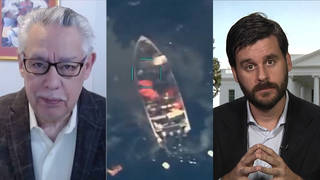
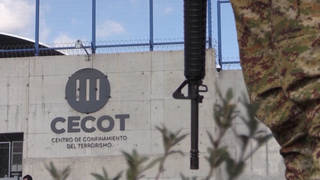
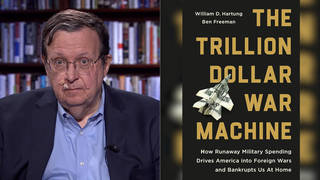
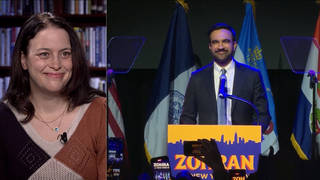





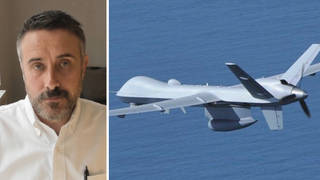
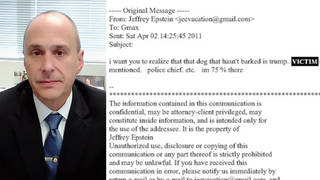
Media Options